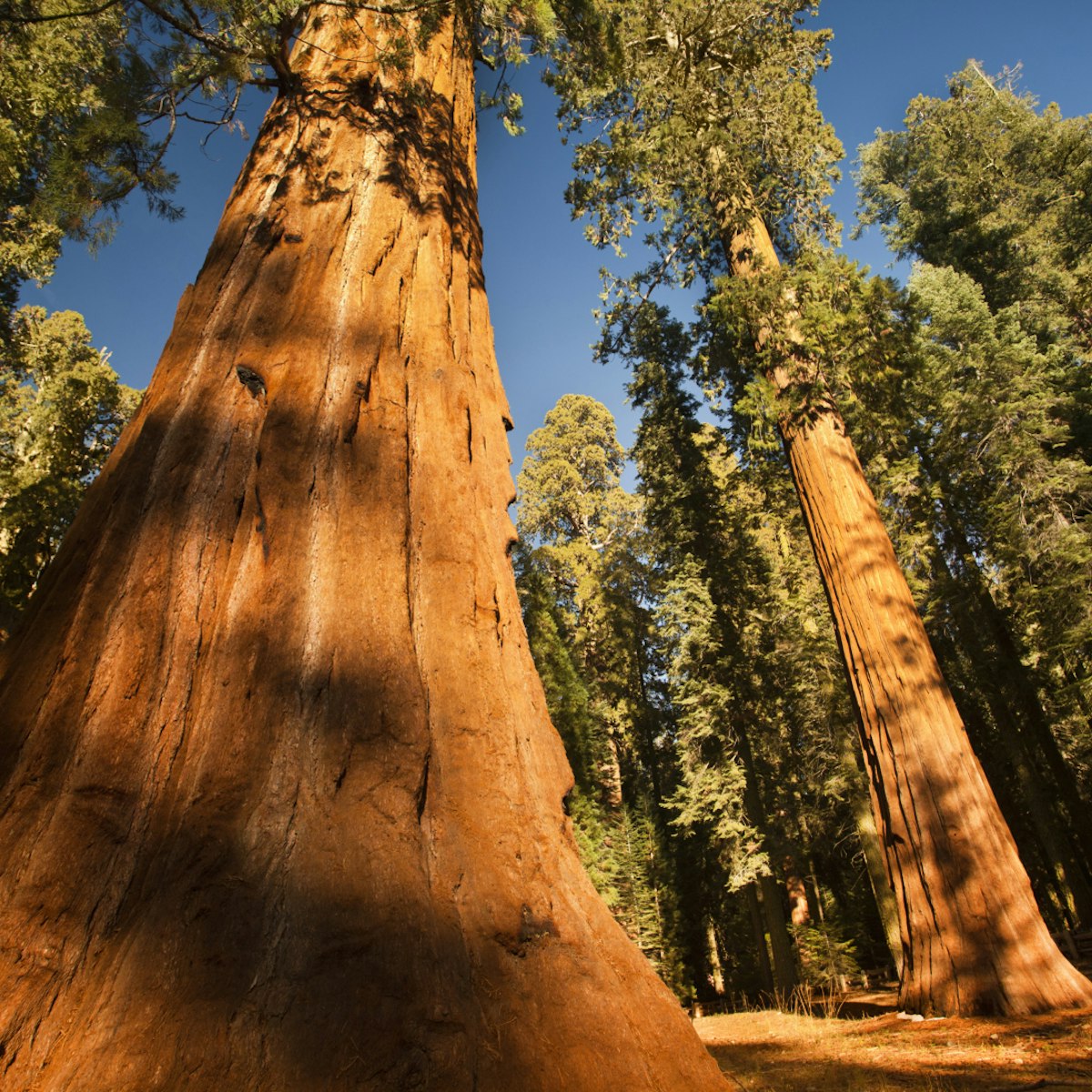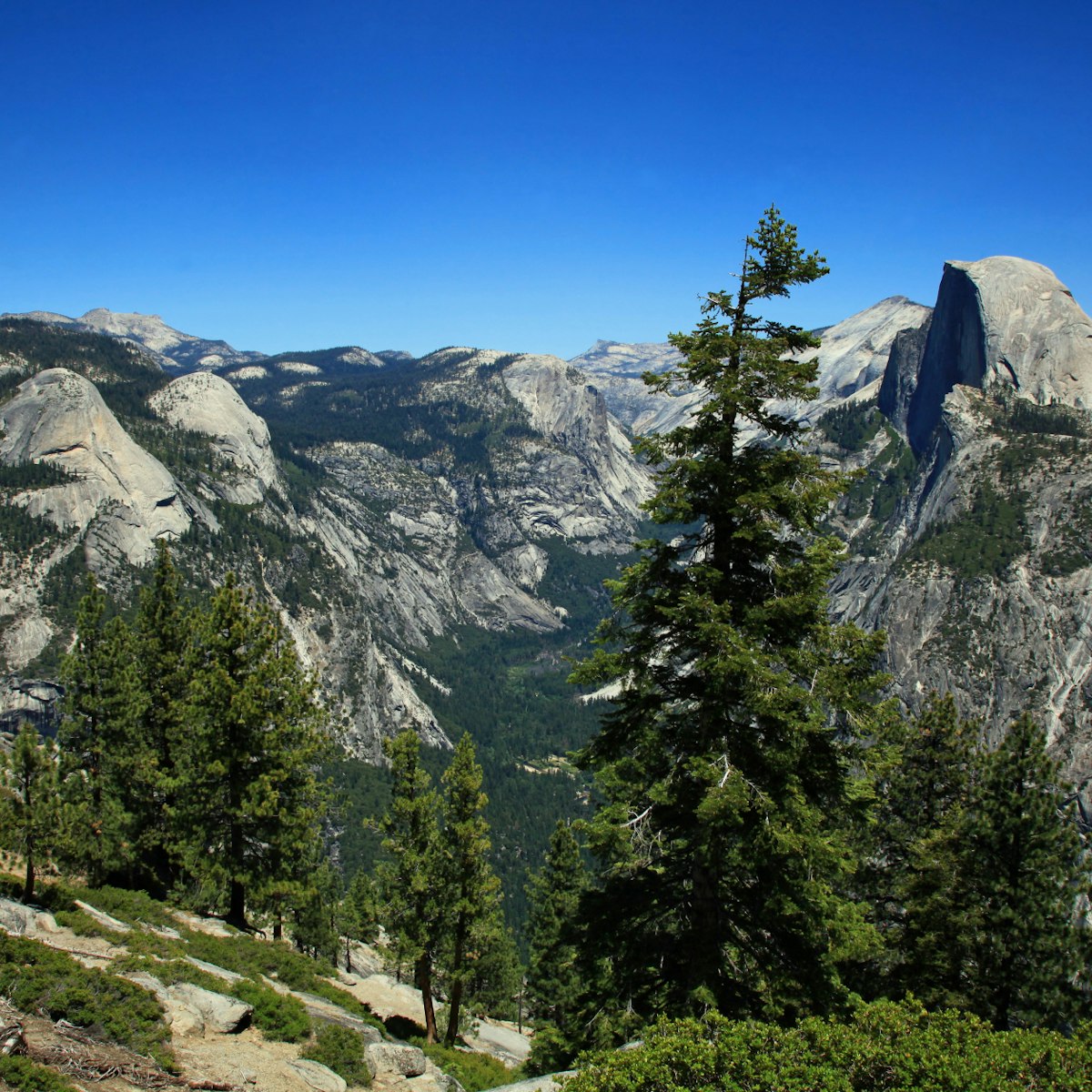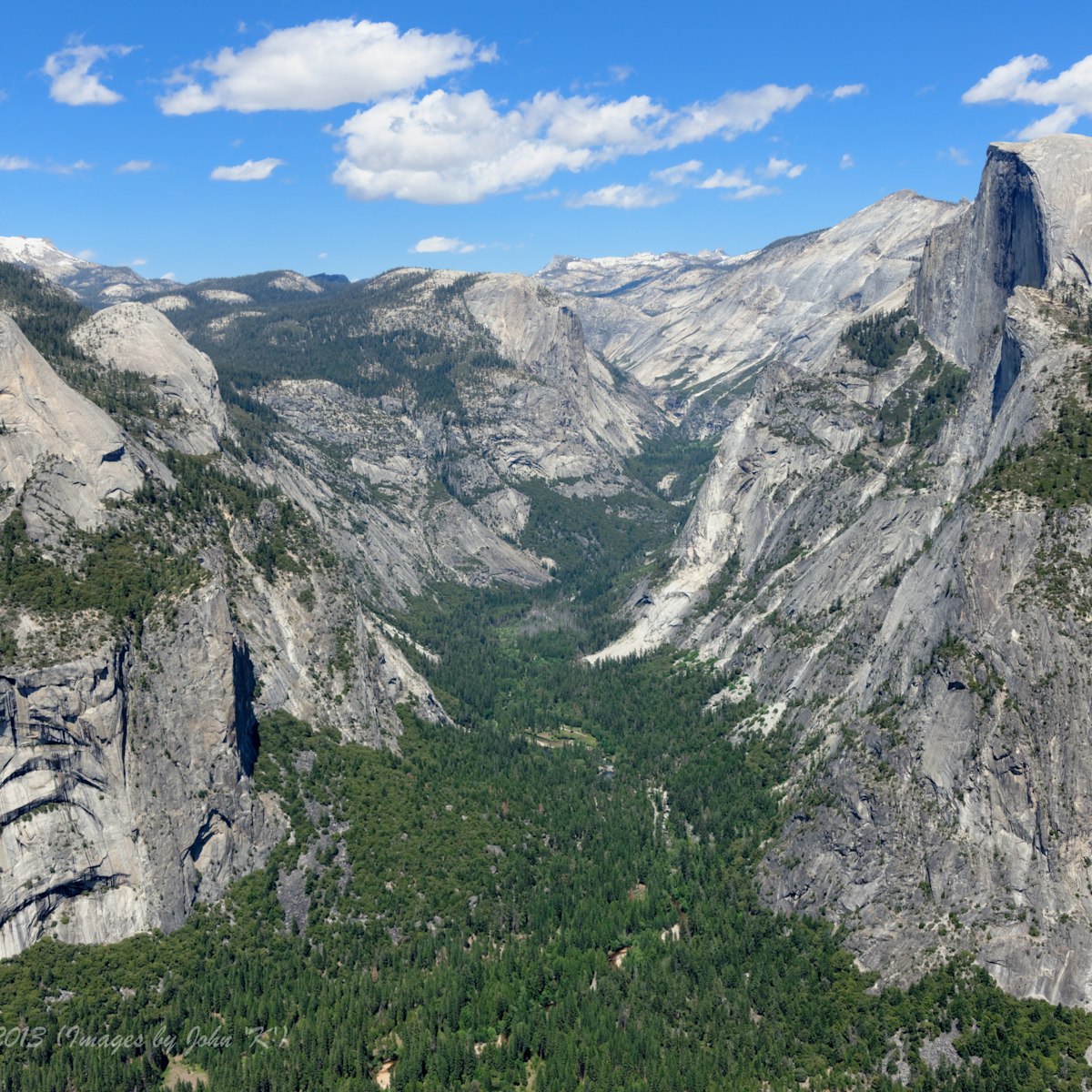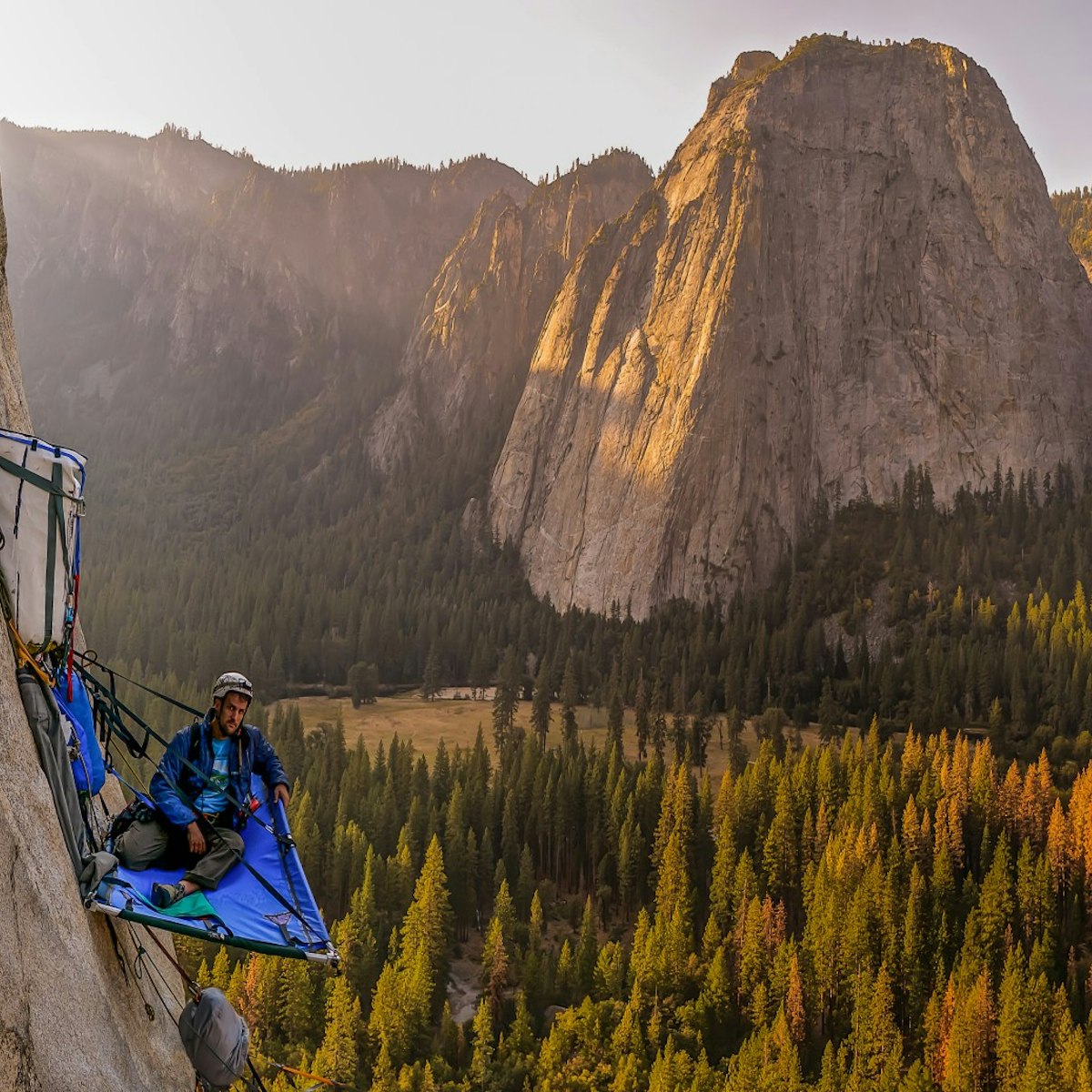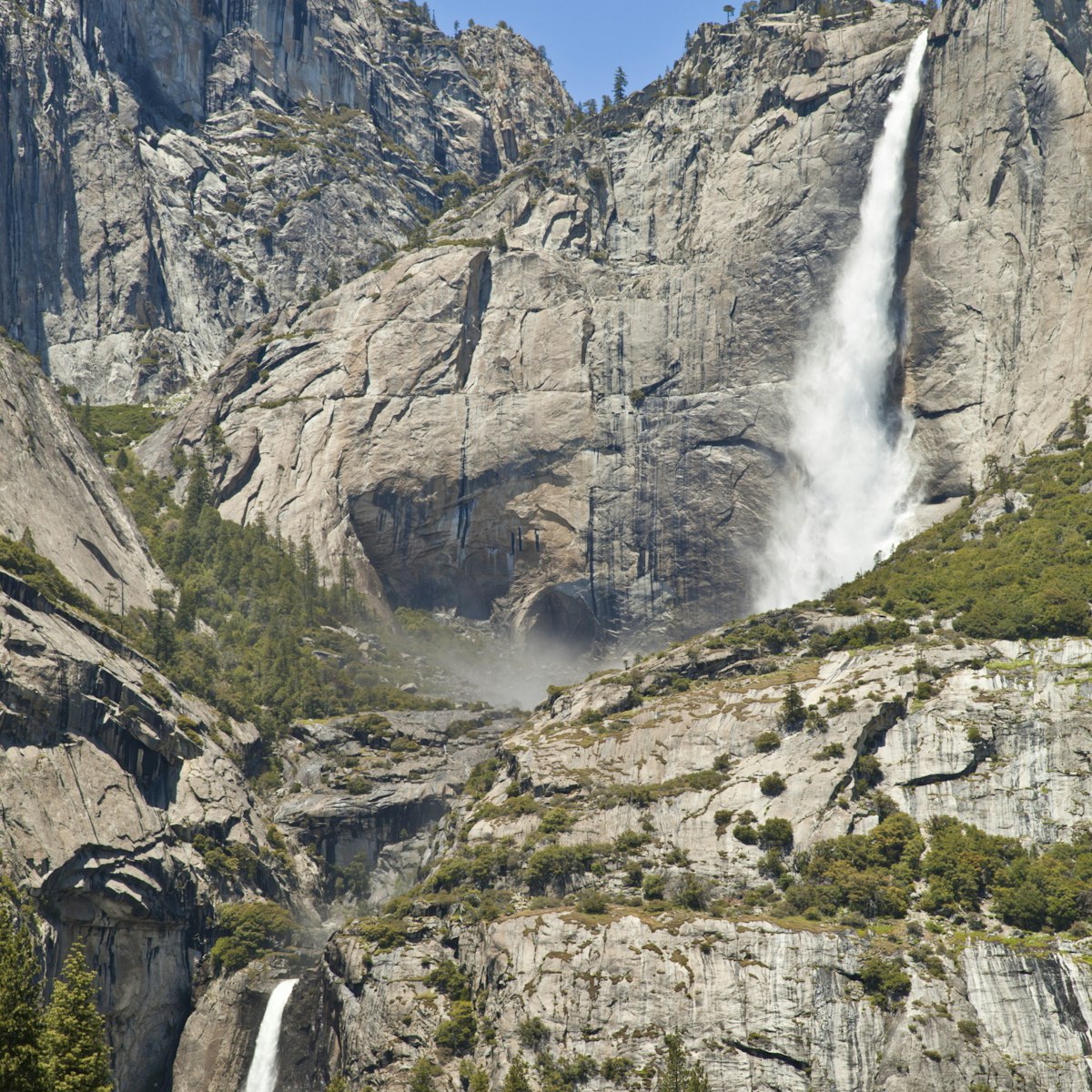Yosemite means "killer" in the Indigenous Miwok language, and in today's parlance it's indeed an impressive, awesome site. Everywhere you look in Yosemite, there are lofty granite domes, sheer cliffs, turbulent rivers, glassy lakes, hypnotizing waterfalls and serene meadows – not to mention spectacular viewpoints to take in all of these and more in a panoramic vision.
The third US national park, Yosemite perhaps best exemplifies the kind of place worth preserving for recreation and conservation, from the park's most recognizable natural features such as Half Dome, El Capitan, Mariposa Grove, and Yosemite Falls, to the summer paradises of Tuolumne Meadows and Glacier Point. It's no wonder that over 5 million visitors arrive every year to take in Yosemite's grandeur.
It was here that conservationist John Muir fell hard for mother nature, penning rhapsodic dispatches on the beauty of the Sierra Nevada that contributed to its preservation as a national park. Yosemite not only stirred Muir, it has also captivated generations of rock climbers who continue to flock to the park's challenging routes and rock faces each year. And the park continues to inspire new ways of considering and experiencing the outdoors – for example, the relatively new sport of slacklining was born in Yosemite from tired climbers trying new tricks in between projects.
Activities in Yosemite
There are over 800 miles of trails, from easy half-mile strolls along the valley floor to overnight backpacking expeditions and thru-hikes. There are 13 campgrounds as well as a number of backcountry sites, with Camp 4 and Tuolumne Meadows attracting close-knit communities of climbers in the summer months. Backpacks, tents and other equipment can be rented from the Yosemite Mountaineering School.
Horseback riding, swimming, rafting and kayaking, skiing, fishing, and even golf and hang gliding can be found here, too. Plus there's Yosemite's after-dark entertainments – in addition to events at the Yosemite Theater, other activities scheduled year-round include campfire programs, children’s photo walks, twilight strolls, night-sky watching, and ranger talks and slide shows. The tavern at the Evergreen Lodge has live bands some weekends, too.
Best views of Yosemite Valley
The park’s crown jewel, the spectacular, meadow-carpeted Yosemite Valley stretches 7 miles long, bisected by the rippling Merced River and hemmed in by some of the most majestic chunks of granite anywhere on earth. Ribbons of water, including some of the highest waterfalls in the US, fall dramatically before crashing in thunderous displays. The counterpoint to the sublime natural scene is bustling Yosemite Village.
The best all-around photo op of the Valley can be had from Tunnel View, a large, busy parking lot and viewpoint at the east end of Wawona Tunnel, on Hwy 41. It’s just a short drive from the Valley floor. The vista encompasses most of the Valley’s icons: El Capitan on the left, Bridalveil Fall on the right, the green Valley floor below, and glorious Half Dome front and center. This viewpoint is often mistakenly called Inspiration Point. That point was on an old park road and is now reachable via a steep hike from the Tunnel View parking lot.
The second view, known as Valley View, is a good one to hit on your way out. It offers a bottom-up (rather than top-down) view of the Valley and is a lovely spot to dip your toes in the Merced River and bid farewell to sights like Bridalveil Fall, Cathedral Rocks and El Capitan. Look carefully to spot the tip-top of Half Dome in the distance. As you head west out of the Valley on Northside Dr, look for the Valley View turnout (roadside marker V11), just over a mile past El Capitan Meadow.
Near the base of Yosemite Falls, the collection of buildings known as Yosemite Valley Lodge includes modern, motel-like accommodations, restaurants, including the recently upgraded Base Camp eatery and Starbucks, shops, a bar, a bicycle-rental stand, a pool, a tour desk and other amenities. The amphitheater hosts regular evening programs, and the pool is open to the public.
The Yosemite Valley shuttle bus stops right out front, as do Yosemite Area Regional Transport System (YARTS) buses. All guided tram tours, ski shuttles and hiker buses also leave from here; tickets are available from the tour desk in the lobby.
Climbing El Capitan
At nearly 3600ft from base to summit, El Capitan ranks as one of the world’s largest granite monoliths. Its sheer face makes it a world-class destination for experienced climbers, and one that wasn’t topped until 1958. Since then, it’s been inundated. Look closely and you’ll probably spot climbers reckoning with El Cap’s series of cracks and ledges, including the famous ‘Nose.’ At night, park along the road and dim your headlights; once your eyes adjust, you’ll easily make out the pinpricks of headlamps dotting the rock face. Listen, too, for voices.
The meadow across from El Capitan is good for watching climbers dangle from granite (you need binoculars for a really good view). Look for the haul bags first – they’re bigger, more colorful and move around more than the climbers, making them easier to spot. As part of the excellent ‘Ask a Climber’ program, climbing rangers set up telescopes at El Capitan Bridge from 12:30pm to 4:30pm (mid-May through mid-October) and answer visitors’ questions. See the Yosemite Guide listing for a schedule.
Half Dome
Rising 8842ft above sea level, and nearly a mile above the valley floor, Half Dome serves as the park’s spiritual centerpiece and stands as one of the most glorious and monumental (not to mention best-known) domes on earth.
Its namesake shape is, in fact, an illusion. While from the valley the dome appears to have been neatly sliced in half, from Glacier or Washburn Points you’ll see that it’s actually a thin ridge with a back slope nearly as steep as its fabled facade. As you travel through the park, witness Half Dome’s many faces. For example, from Mirror Lake it presents a powerful form, while from the Panorama Trail it looks somewhat like a big toe poking out above the rocks and trees.
Glacier Point
Constructed to replace an 1882 wagon road, the modern 16-mile stretch of Glacier Point Rd leads to what many people consider the finest viewpoint in Yosemite. A lofty 3200ft above the valley floor, 7214ft Glacier Point presents one of the park’s most eye-popping vistas and practically puts you at eye level with Half Dome.
Lying directly below Glacier Point, Half Dome Village is home to Yosemite Valley’s second-biggest collection of restaurants, stores and overnight accommodations. Originally called Camp Curry, it was founded in 1899 by David and Jennie Curry as a place where everyday visitors could find ‘a good bed and a clean napkin at every meal.’ Starting with just a handful of tents, the camp quickly grew, thanks in large part to David Curry’s entrepreneurial drive and booming personality. One of his biggest promotional schemes was the Firefall, a nightly event and significant tourist draw.
Yosemite Falls
One of the world’s most dramatic natural spectacles, Yosemite Falls is a marvel to behold. Naturalist John Muir devoted entire pages to its changing personality, its myriad sounds, its movement with the wind and its transformations between the seasons. No matter where you are when you see it (and it regularly pops into view from all over the Valley), the falls will stop you in your tracks.
In spring, when snowmelt gets Yosemite Creek really pumping, the sight is astounding. Another sign of springtime is 'frazil ice', the strange slurry – not exactly ice or snow – that moves like lava from the bottom of the falls under Yosemite Creek bridges. On nights when the falls are full and the moon is bright, especially in May and June, you might spot a ‘moonbow’ (aka lunar rainbow or spraybow). In winter, as the spray freezes midair, an ice or snow cone, depending on its density, forms at the base of the falls and can top out at several hundred feet.
To get to the base of Lower Yosemite Fall, get off at shuttle stop 6 (or park in the lot just north of Yosemite Valley Lodge) and join the legions of visitors for the easy quarter-mile stroll. Note that in midsummer, when the snowmelt has dissipated, both the upper and lower falls usually dry up – sometimes to a trickle, other times stopping altogether.
Bridalveil Fall
In the southwest end of Yosemite Valley, Bridalveil Fall tumbles 620ft. The Ahwahneechee people call it Pohono (Spirit of the Puffing Wind), as gusts often blow the fall from side to side, even lifting water back up into the air. This waterfall usually runs year-round, though it’s reduced to a whisper by midsummer. Bring rain gear or expect to get wet when the fall is heavy.
Take the seasonal El Capitan shuttle or park at the large lot where Wawona Rd (Hwy 41) meets Southside Dr. From the lot, it’s a quarter-mile walk to the base of the fall. The path is paved, but probably too rough for wheelchairs, and there’s a bit of an uphill at the very end. Avoid climbing on the slippery rocks at its base – no one likes a broken bone. The Yosemite Conservancy is planning to remodel the usually overflowing parking lot and trail access to make it more visitor friendly.
If you’d rather walk from the Valley, a trail (part of the Loop Trails) follows Southside Dr, beginning near the Yosemite Heritage Conservation Center and running about 3.8 miles west to the falls.
Tuolumne Meadows
About 55 miles from Yosemite Valley, 8600ft Tuolumne Meadows is the largest subalpine meadow in the Sierra. It provides a dazzling contrast to the valley, with its lush fields, clear blue lakes, ragged granite peaks and domes, and cooler temperatures. During July or August, you’ll find a painter’s palette of wildflowers decorating the meadows. Hikers and climbers will find a paradise of options.
Satisfying burgers and hot dogs, not to mention a few salads, are served up at Tuolumne Meadows Grill. Grab a seat outside at a picnic table. Tuolumne Meadows Store has everything you need to pack a picnic lunch.
Tuolumne Meadows sits along Tioga Rd (Hwy 120) west of the park’s Tioga Pass Entrance. The Tuolumne Meadows Hikers’ Bus makes the trip along Tioga Rd once daily in each direction, and can be used for one-way hikes. There’s also a free Tuolumne Meadows Shuttle, which travels between the Tuolumne Meadows Lodge and Olmsted Point, including a stop at Tenaya Lake.
The Majestic Yosemite Hotel
Almost as iconic as Half Dome itself, the elegant Majestic Yosemite Hotel has drawn well-heeled tourists through its towering doors since 1927. Of course, you needn’t be wealthy in the least to partake of its many charms. In fact, a visit to Yosemite Valley is hardly complete without a stroll through the Great Lounge (aka the lobby), which is handsomely decorated with leaded glass, sculpted tile, Native American rugs and Turkish kilims.
You can relax on the plush but aging couches and stare out the 10 floor-to-ceiling windows, wander into the Solarium, or send the kids into the walk-in fireplace (no longer in use) for a photo. You can even sneak up the back stairs for a peek into the private Tudor Room, which has excellent views over the Great Lounge.
The hotel was designed by American architect Gilbert Stanley Underwood, who also designed Zion Lodge, Bryce Canyon Lodge and Grand Canyon North Rim Lodge. If the hotel’s lobby looks familiar, perhaps it’s because it inspired the lobby of the Overlook Hotel, the ill-fated inn from Stanley Kubrick’s The Shining.
Yosemite Ski Area
The California ski industry essentially got its start in Yosemite Valley, and Badger Pass (now called the Yosemite Ski & Snowboard Area) was California’s first alpine ski resort. After Yosemite’s All-Year Hwy (now Hwy 140) was completed in 1926 and the Ahwahnee Hotel (now called the Majestic Yosemite Hotel) opened its doors the following year, Yosemite Valley quickly became a popular winter destination.
When Wawona Tunnel opened in 1933, skiers began congregating at Badger Pass. In 1935, a new lodge opened on Glacier Point Rd, and a newfangled device called ‘the upski’ was installed at the pass. The crude lift consisted of nothing more than two counterbalanced sleds, but it worked, and this place became California’s first alpine ski resort.
In winter, a free shuttle bus runs between the Valley and the Yosemite Ski & Snowboard Area. Also in winter, wilderness permits are available by self-registration at the A-frame building, where the first-aid station and ski patrol are also situated. Rangers usually staff the office from 8am to 5pm.
The history of Yosemite National Park
The Ahwahneechee, a group of Miwok and Paiute peoples, lived in the Yosemite area for around 4000 years before a group of pioneers, most likely led by explorer Joseph Rutherford Walker, came through in 1833. There were an estimated 3000 people living in 22 villages in the valley alone. During the gold-rush era, conflict between the miners and native tribes escalated to the point where a military expedition (the Mariposa Battalion) was dispatched in 1851 to punish the Ahwahneechee, eventually forcing the capitulation of Chief Tenaya and his tribe.
Tales of thunderous waterfalls and towering stone columns followed the Mariposa Battalion out of Yosemite and soon spread into the public’s awareness. In 1855, San Francisco entrepreneur James Hutchings organized the first tourist party to the valley. Published accounts of his trip, in which he extolled the area’s untarnished beauty, prompted others to follow, and it wasn’t long before inns and roads began springing up.
Alarmed by this development, conservationists petitioned Congress to protect the area – with success. In 1864 President Abraham Lincoln signed the Yosemite Grant, which eventually ceded Yosemite Valley and the Mariposa Grove of Giant Sequoias to California as a state park. This landmark decision, along with the pioneering efforts of conservationist John Muir, led to a congressional act in 1890 creating Yosemite National Park; this, in turn, helped pave the way for the national-park system that was established in 1916.
Yosemite Tickets and Tours
Admission to Yosemite costs $35 per car, $30 per motorcycle, $20 per person on foot or by bicycle.
Guided tour packages are offered by a number of third-parties, including some based within the park and some outside its bounds:
Yosemite Conservancy - Park-affiliated nonprofit offers multiday courses, custom trips and seminars that are great alternatives to tours.
Sierra Club - The national environmental nonprofit has both paid trips and free activity outings sponsored by local chapters.
Discover Yosemite Tours - Operates bus tours year-round from Oakhurst, Fish Camp and Bass Lake.
Aramark/Yosemite Hospitality - The park’s main concessionaire runs bus and tram tours, including a very popular wheelchair-accessible two-hour Valley Floor Tour and day trips from the Valley to either Glacier Point or Tuolumne Meadows. Stop at the tour and activity desks at Yosemite Valley Lodge, Half Dome Village or Yosemite Village; call 209-372-4386; check www.travelyosemite.com; or the Yosemite Guide for information and pricing.
Tenaya Lodge - Large family-friendly resort in Fish Camp operates full-day park tours in luxurious Mercedes Benz buses with retractable roofs that allow you to experience the natural sights a little more naturally. Guests of the lodge have priority.
Green Tortoise - Runs backpacker-friendly two-day ($300) and three-day ($360) trips to Yosemite from San Francisco where travelers sleep in the converted bus or in campgrounds, cook collectively and choose from activities like hiking, swimming or just hanging out (and there’s always some great hanging out). Prices (which change annually) include most meals and the park entry fee.
Incredible Adventures - This outfit uses biodiesel vans for its San Francisco–based tours to Yosemite, from one-day sightseeing tours ($159) to three-day camping tours ($489). Park entry fees and most meals are included, and it provides all cooking and camping gear except sleeping bags.















